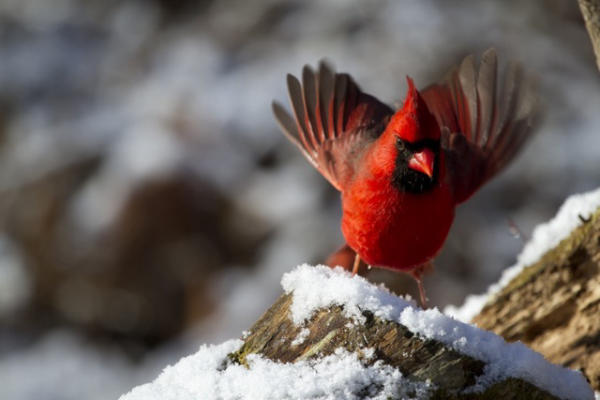With temperatures in the teens, several inches of snow on the ground and a windchill in the sub-zero range, many of us who never have to deal with these kinds of conditions are shivering in our homes, avoiding travel when possible and wondering how long we’ll have to tolerate these seemingly intolerable conditions.
Looking out our windows, the occasional bird makes us also wonder just how in the world they manage to survive conditions that cover up their normal food sources, chill their body temperatures and make for IFR flying conditions.

A northern cardinal at Shenandoah National Park in Virginia taking advantage of a little solar heating. Photo by National Park Service with permission.
We went looking for some answers and found out that the birds aren’t really all that different from the rest of us. They’re adapting.
According to Charles Eldermire, the Bird Cams Project Leader at the Cornell Lab of Ornithology, the birds have a basic rule: Feathers + Food Equals Warmth.
Eldermire offers a five-step survival guide that boils their survival down to the essence:
- Hang around with others when possible. When you see birds in the wintertime, they’re generally flocked. He says there are several reasons for that. First, when you’re in a group, you have more eyes looking around- and that means fewer chances of something looking for food eating you. Flocking also means more birds foraging, saving energy in the search for food.
- If you find a feeder, park in front of it and chow down. From feeders to seedy plants, you want to find all you can, eat all you can, and keep eating. Birds want the heaviest, fattiest foods possible (like black-oil sunflower and suet if you’re looking for something good to offer up for them) but there’s also a downside. Eat too-much and you’ll be slower. In the world of the bird- like the horror movie- the slower you are, the more the likelihood you’ll wind up as someone else’s dinner.
- If you can’t eat more, just get puffy and rest. Their fluffy down feathers serve the same purpose as the ones in your puffy winter coat. You can use your own metabolism to generate heat. Feathers do a great job of keeping body heat in while keeping cold air out. Eldermire says we should take pity on the woodpeckers of the world because they lack down feathers.
- Stay out of the wind. Doesn’t take much explanation, does it? If the wind is howling from the east, get on the other side of the tree, shrub or feeder. Less wind is better.
- If you find shelter, get in it. The warmest our feathered friends can get is snugged into a small cavity where their down feathers can do their job at keeping in warmth and the small cavity will help keep any heat that does escape around their bodies.
- In an ideal world, combine all the prior ideas together. Eat, stay puffy, rest and conserve energy.
Fortunately for the birds, and the rest of us, winter is a temporary condition in the south.
